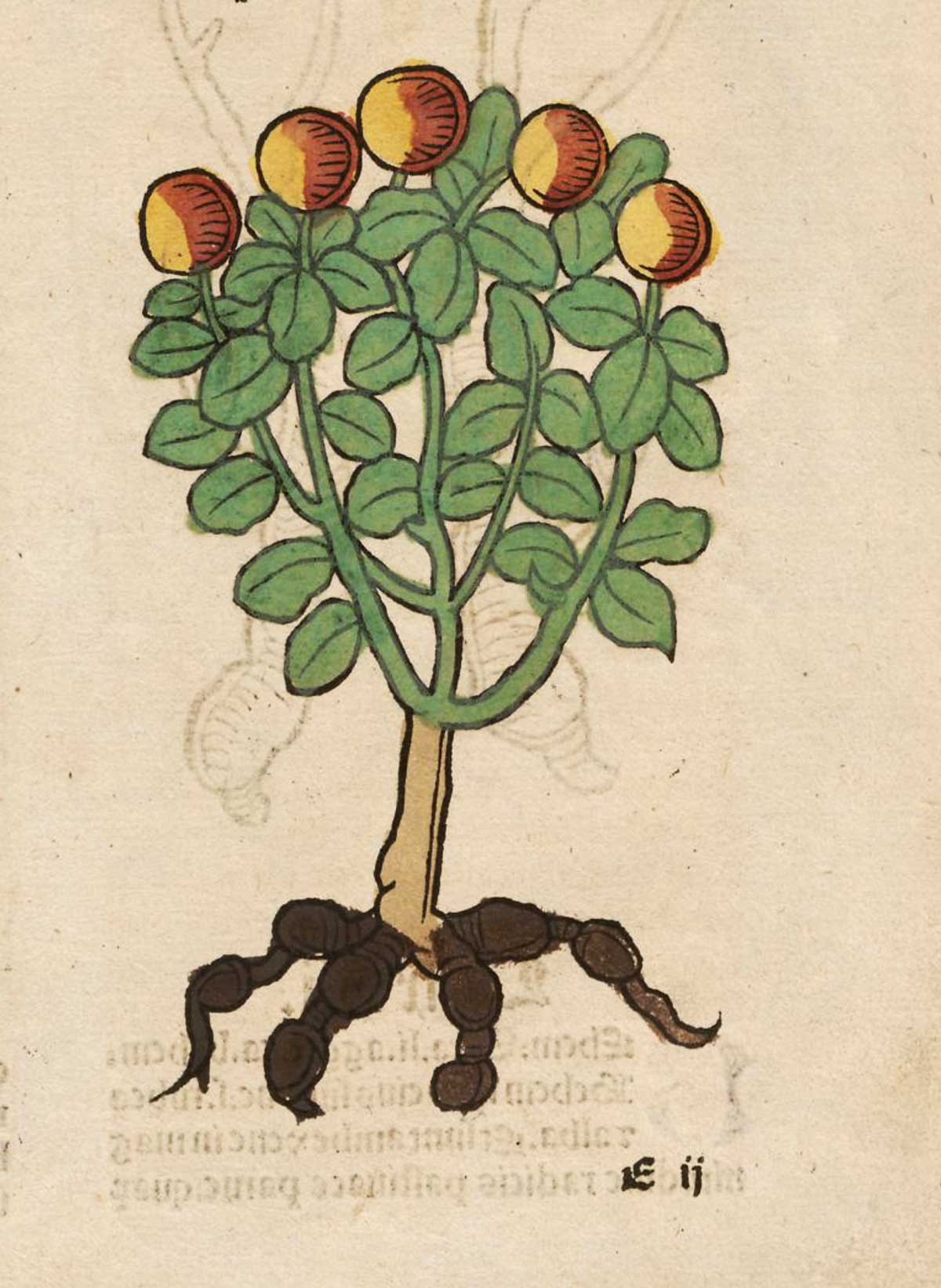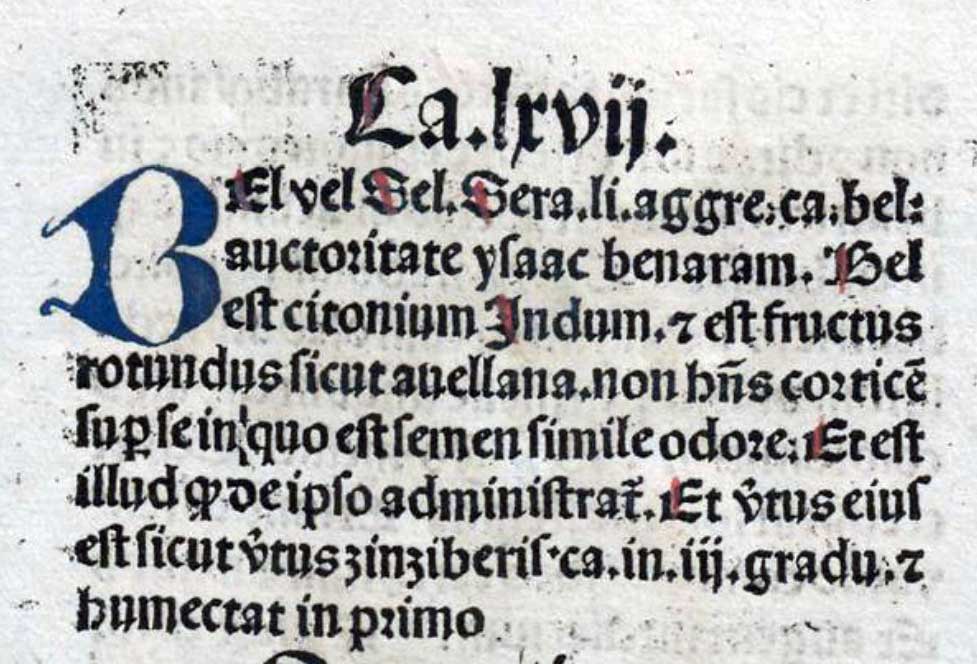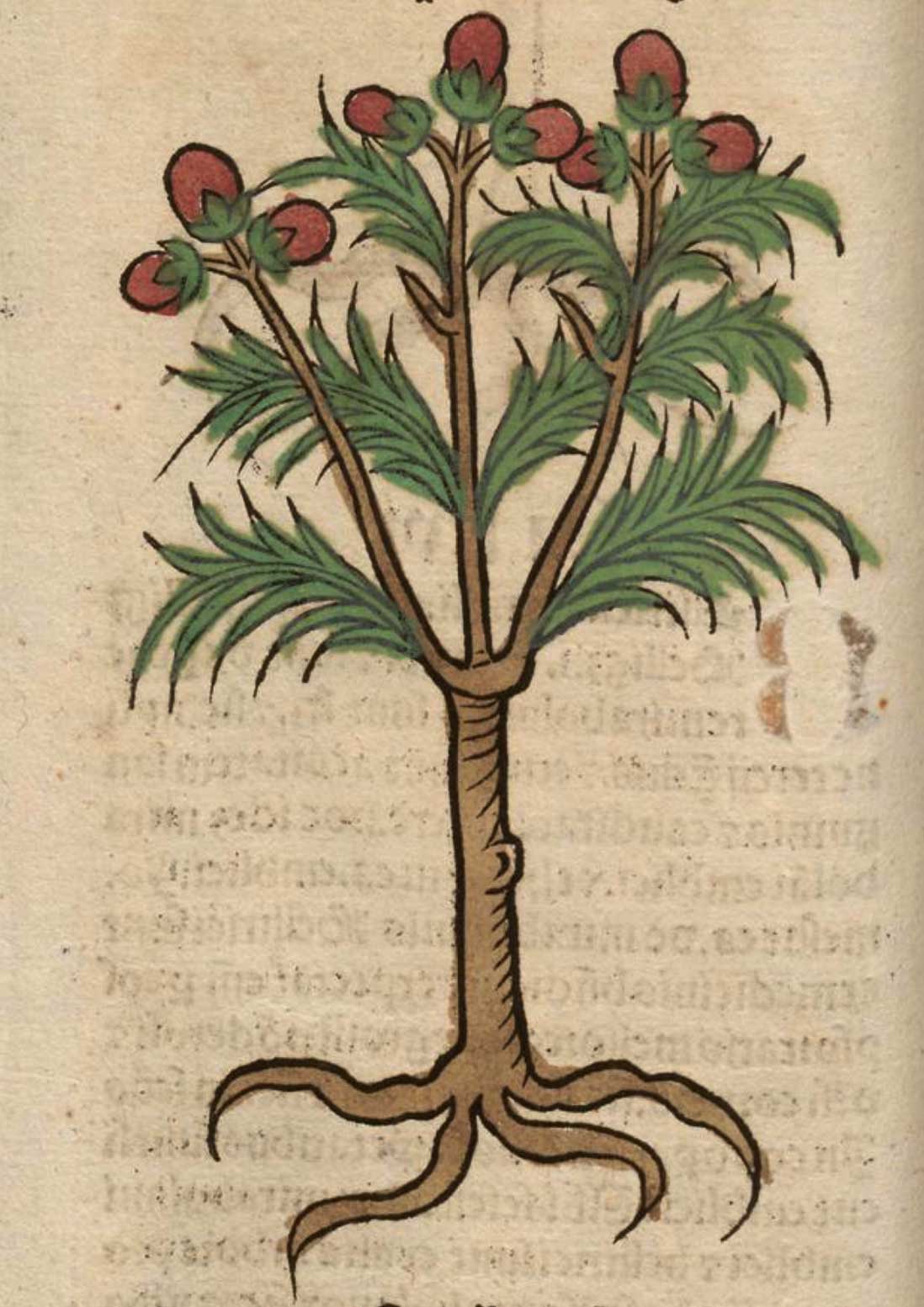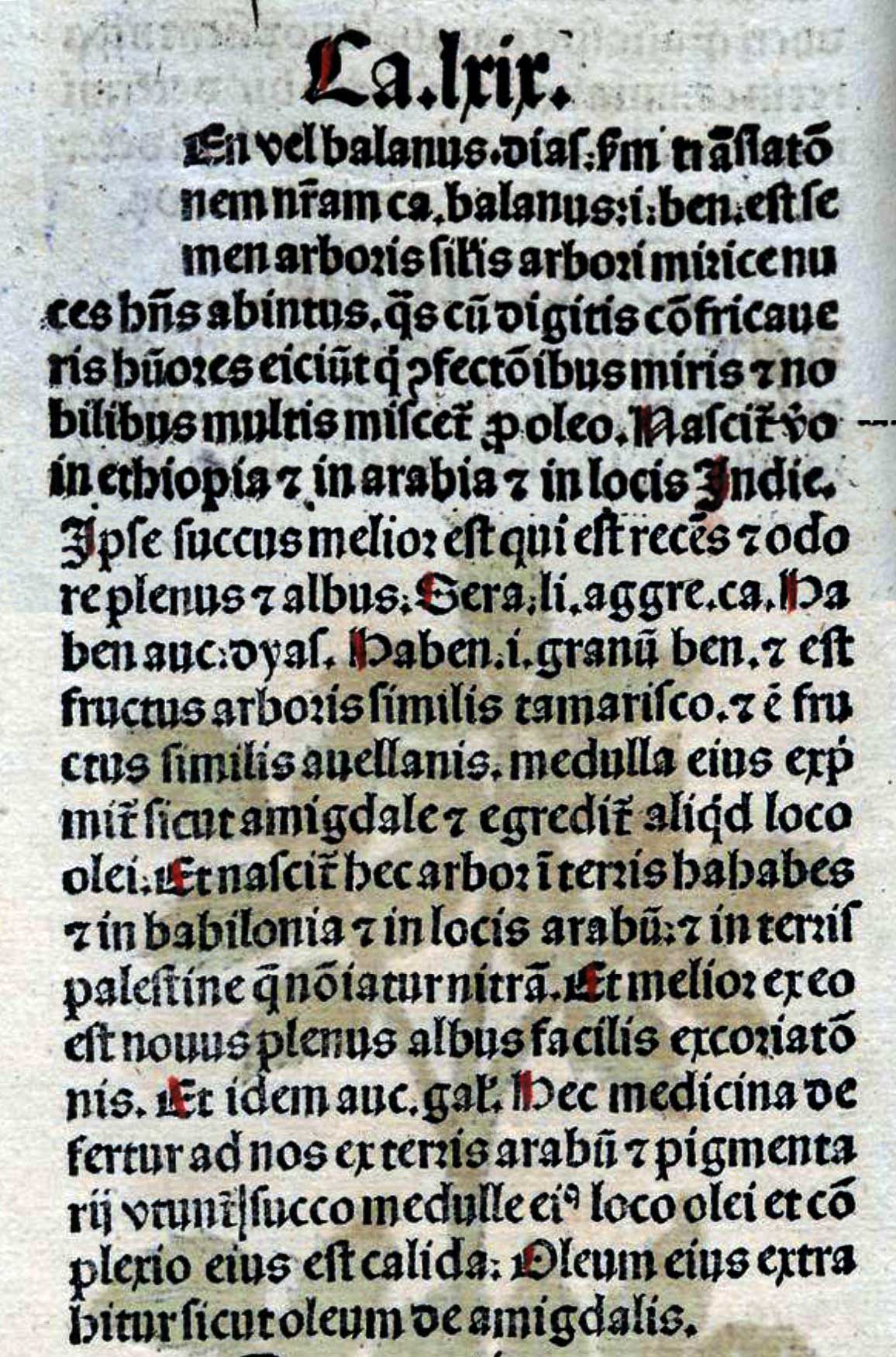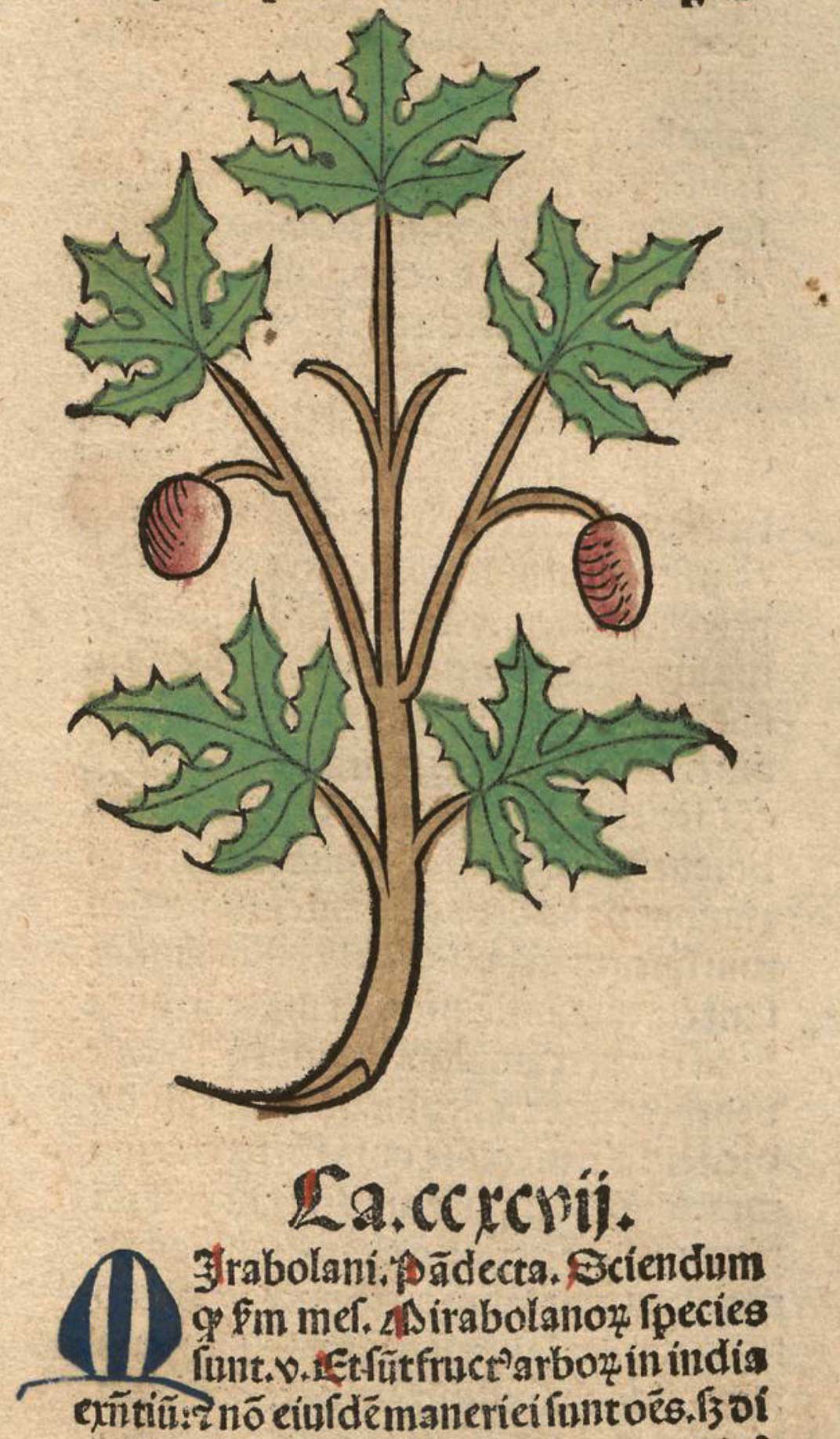myrobalans, which the Arabs call
Original French: Myrobalans, que les Arabes appellent
Modern French: Myrobalans, que les Arabes appellent
Among the plants named for their forms. The plants in this group also appear in Charles Estienne’s De Latinis et Graecis nominibus…[1], published in Paris in 1544, two years before the first edition of the Le Tiers Livre[2].
1. Estienne, Charles (1504–1564), De Latinis et Graecis nominibus arborum, fruticum, herbarum, piscium & avium liber : ex Aristotele, Theophrasto, Dioscoride, Galeno, Nicandro, Athenaeo, Oppiano, Aeliano, Plinio, Hermolao Barbaro, et Joanne Ruellio : cum Gallica eorum nominum appellatione. Paris: 1544. Bibliothèque nationale de France
2. Rabelais, François (1494?–1553), Le Tiers Livre des faictz et dictz Heroïques du noble Pantagruel: composez par M. François Rabelais docteur en Medicine, & Calloïer des Isles Hieres. L’auteur susdict supplie les Lecteurs benevoles, soy reserver a rire au soixante & dixhuytiesme livre. Paris: Chrestien Wechel, 1546. Gallica
Notes
Bel citronium
Bel citronium (text)
Balanus
Balanus (text)
Mirabolani
Moringa oleifera Lam.
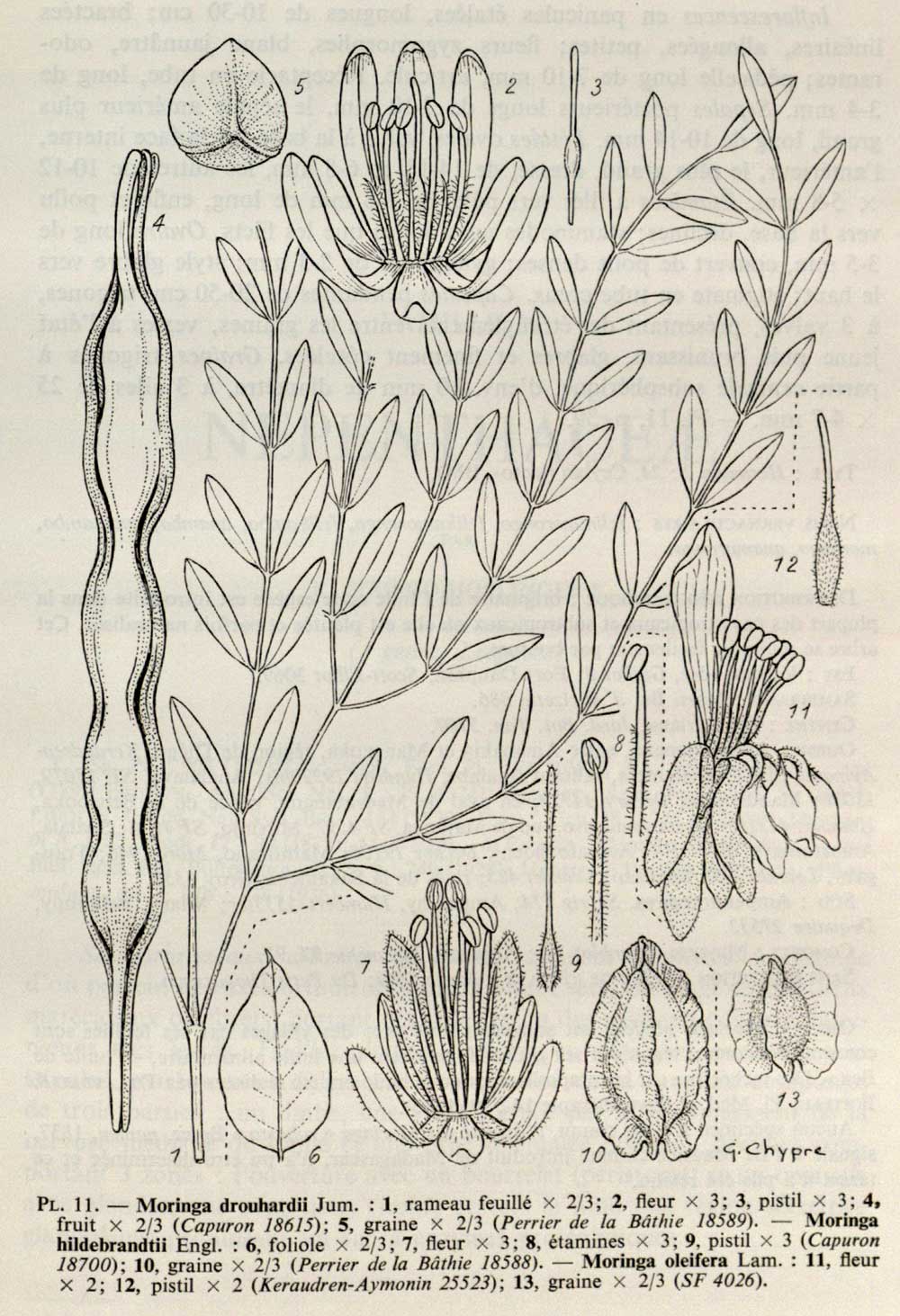
Moringa oleifera Lam.
vernacular name: horseradish tree
myrobalans
XLVI. Myrobalanum Trogodytis et Thebaidi et Arabiae qua Iudaeam ab Aegypto disterminat commune est, nascens unguento, ut ipso nomine apparet, quo item indicatur et glandem esse; arbor est heliotropio, quam dicemus inter herbas, simili folio, fructus magnitudine abellanae nucis. ex his in Arabia nascens Syriaca appellatur, et est candida, contra in Thebaide nigra; praefertur illa bonitate olei quod exprimitur, sed copia Thebaica. inter haec Trogodytica vilissima est. sunt qui Aethiopicam his praeferant glande nigra ac pingui nucleoque gracili, sed liquore qui exprimitur odoratiore, nascentem in campestribus. Aegyptiam pinguiorem esse et cras siore cortice rubentem et, quamvis in palustribus nascatur, breviorem siecioremque, e diverso Arabicam viridem ac tenuiorem et, quoniam amet montuosa, spissiorem; longe autem optimam Petraeam ex quo diximus oppido, nigro cortice, nucleo candido. unguentarii autem tantum cortices premunt, medici et nucleos, tundentes adfusa paulatim calida aqua.
XLVI. The Cave-dweller country and the Thebaid and Arabia where it separates Judaea from Egypt all alike have the myrobalanum, [Μυροβάλανον, ‘perfume-nut,’ the behen-nut] which is grown for scent, as is shown by its name itself, which also indicates in addition that it is a nut; it is a tree with a leaf that resembles that of the heliotrope, which we shall describe among the herbaceous plants, and a fruit the size of a hazel-nut. The variety growing Arabia is called the Syrian nut, and is white in colour, whereas the Thebaid kind is black; the former is preferred for the excellent quality of the oil extracted from it, but the Thebaic for its large yield. The Cave-dweller kind is the worst among the varieties. Some persons prefer to these the Ethiopian behen, which has a black oily nut and a slender kernel, but the liquid squeezed out of it has a stronger scent; it grows in level districts. It is said that the Egyptian nut is even more oleaginous and has a thicker shell of a reddish colour, and that though it grows on marshy ground the plant is shorter and drier, whereas the Arabian variety, on the contrary, is green in colour and also smaller in size and more compact in shape because it likes mountain regions; but the Petraean kind, coming from the town mentioned above, is a long way the best—it has a black rind and a white kernel. Perfumiers, however, only extract the juice from the shells, but medical men also crush the kernels, gradually pouring warm water on them while pounding them.
myrobalanum
LII. Palma quae fert myrobalanum probatissima in Aegypto. ossa non habet reliquarum modo in balanis, alvum et menses sistit in vino austero et vulnera conglutinat.
The palm which bears the myrobalanum, found in Egypt, is very highly esteemed. It has no stone in its dates, as other date-palms have. Taken in a dry wine it checks diarrhoea and excessive menstruation, and unites wounds.
Note: In chapters LII and LIII Pliny seems to have completely misunderstood and confused his authorities. Dioscorides says that the date is Egyptian, and resembles the Arabian myrobalanum. According to him the spalhe is “the covering of the fruit of palma when these are at their prime (?):” περικάλυμμά ἐστι τοῦ καρποῦ τῶν φοινίκων ἀκμὴν ἀνθούντων. Pliny on the other hand speaks of “the palm which bears the myrobalanum,” giving it (or its fruit) the properties attributed by Dioscorides to the Egyptian date. He goes on to say that the spathe was a palm with medicinal properties in its sprigs, leaves and bark.
Among Pliny’s mistakes seems to be the confusion of ben nut (myrobalanum) with what is called by Dioscorides φοινικοβάλανος. Cf. Pliny XII. § 103. The conjecture of Hardouin (refert) clears away one discrepancy between Dioscorides and Pliny if we take palma in the first sentence of § 98 to mean “date,” but then the words in balanis become oddly otiose. No emendation, however, can make spathe in § 99 mean anything but a tree; it certainly cannot mean the περικάλυμμα τοῦ καρποῦ of Dioscorides.
mirobolans
Du grec μυροξαλανοζ, unguentaria glans; mot composé de μυρον, ungentum liquidum, et ξαλανοζ, glans. En effet, comme le dit Martial:
Hoc ex unguento constat et ex balano.
Myrobolans
Cf. ii. 14.
myrobalans
Mirobolanz (Platearius), myrobalan, mirobolan (Antid. Nicholas), Mirabolain (Hortus sanit., 1500). — «Myrobalanum Troglodytis et Thebaïdi et Arabiae… commune est, nascens unguento, quo item indicatur et glandem esse arboris, heliotropio… simili folio», Pline, XII, 46. Fée veut y reconnaître le Morgina oleifera, Lmk. (M. pterygosperma, Gærtn.) des Indes orientales. Il parait plus probable de rapporter le myrobolan des Anciens, avec de Candolle et Planchon, à Moringa aptera, Gærtn. Quant aux myrobalans de la pharmacopée moderne, inconnus aux Anciens, et introduits dans la thérapeutique par les Arabes, ce sont des drupes de diverses esp. du G. Terminalia (Combrétacée) de l’Inde, et des fruits de l’Emblica officinalis, Gærtn. (Euphorbiacée). (Paul Delaunay)
Les aultres de leurs formes
Encore une fois, tout cela se retrouve dans le petit livre de Charles Estienne, De latinis nominibus.
Les aultres de leurs formes
Toutes ces informations sont dans le livre d’Estienne. L’étymologie de «serpoullet» (du lat. serpere) est indiquée par Pline, XX, 22 («herper» : ramper?). Calepin signale celle de myrobolan, «quam Dioscorides Βάλανον μυρεψικήν appellat, hoc est glandem unguentariam»; de là la précision terminale de Rabelais. Voir aussi Manardi, dans ses annotations sur les Simples de Mésué, à l’article «De ben».
myrobalan
myrobalan. [adopted from French myrobolan or its source Latin myrobalanum, adopted from Greek murobalanoj(1) perhaps the ben-nut, (2) in modern Greek, emblic, formed on muro-n unguent, balsam + balanoj acorn, date, ben-nut. Known colloquially amongst dyers as m’rabs.]
The astringent plum-like fruit of species of Terminalia (N.O. Combretaceæ), e.g. T. Bellerica, T. Chebula, T. citrina: formerly used medicinally, but now chiefly in dyeing, tanning, and ink-making.
1530 Jehan Palsgrrave Leclarcissement de la langue françoyse. 245/2 Mirabolon a frute, mirabolan.
1533 Sir Thomas Elyot The castel of helth (1541) 68 Myrabolones, callyd Kebuli. C.
1540 in Vicary’s Anat. (1888) 226 Putt therto of mirobolane cytrine pouldered, one vnce.
1562 Bullein Bulwarke, Bk. Simples (1579) 62 Who so vseth to eate often of Myrobalans being condite, shall not seeme olde, sayth Mesue.
1610 Ben Jonson The Alchemist. iv. ii, Shee melts Like a Myrobalane.
1611 Randle Cotgrave, A dictionarie of the French and English tongues, Myrobalan citrin, the yellow, or Citron Myrobalan.
1626 Francis Bacon Sylva sylvarum; or a naturall historie §644 There be Fruits, that are Sweet before they be Ripe; As Myrabolanes.
1712 tr. Pomet’s Hist. Drugs I. 141 The Indian Myrobalans are small long Fruit, of the Size of a Child’s Finger End.
attributive, as myrobalan tree; myrobalan ben, date, the ben-nut; myrobalan plum
1555 Eden Decades (Arb.) 100 A greate multitude of certeine beastes.. creping as thicke as antes aboute the myrobolane trees.
1598 Florio, Citrino,… a kinde of mirabolane plum.
1601 Philemon Holland, translator Pliny’s History of the world, commonly called the Natural historie xii. xxii. II. 163 Of the Myrabolan Date.
